Prospecting Prediction for the Yulong Metallogenic Belt in Tibet Based on Remote Sensing Alteration Information and Structural Interpretation
Abstract
:1. Introduction
2. Geological Setting of Yulong Porphyry Copper Belt
3. Materials and Methods
3.1. Remote Sensing Data and Preprocessing
3.1.1. Landsat-8 and ASTER
3.1.2. GF-5 and ZY1-02D
3.1.3. Sentinel-1
3.2. Alteration Information Extraction
3.2.1. Multispectral Mineralization Alteration Anomaly Extraction
3.2.2. Mineral Identification Based on Hyperspectral Data
3.3. Structural Interpretation of Remote Sensing
4. Results
4.1. Alteration Anomaly Extraction
4.2. Structural Interpretation Results
4.3. Comprehensive Analysis of Multiple Information and Optimization of Planned Prospecting Area
5. Discussion
6. Conclusions
Author Contributions
Funding
Data Availability Statement
Acknowledgments
Conflicts of Interest
References
- Tang, C.; Chen, J.P.; Zhang, R.S.; Pei, Y.R. Alteration from Aster Remote Sensing Data in Ban Nu Metallogenic Belt, Gaize, Tibet. Remote Sens. Tech. Appl. 2013, 28, 122–128. [Google Scholar]
- Pour, A.B.; Park, T.S.; Hong, J.K.; Muslim, A.M.; Läufer, A.; Crispini, A.; Pradhan, B.; Zoheir, B.; Hashim, M.; Hossain, M.S. Landsat-8, Advanced Spaceborne Thermal Emission and Reflection Radiometer, and WorldView-3 Multispectral Satellite Imagery for Prospecting Copper-Gold Mineralization in the Northeastern Inglefield Mobile Belt (IMB), Northwest Greenland. Remote Sens. 2019, 11, 2430. [Google Scholar] [CrossRef]
- Guha, A.; Saw, A.K.; Mukherjee, A.; Verma, C.B.; Kumar, K.V.; Rao, P.V.N.; Diwakar, P.G. Eigen vector based analysis of Landsat OLI principal components and constrained energy minimization maps for discriminating iron enriched zones in banded iron formation (BIF) in Sidhi, Madhya Pradesh. Geocarto Int. 2022, 37, 1880–1898. [Google Scholar] [CrossRef]
- Bai, L.Y.; Dai, J.J.; Song, Y.; Liu, Z.B.; Chen, W.; Wang, N.; Wu, C.Y. Predictive Prospecting Using Remote Sensing in a Mountainous Terrestrial Volcanic Area, in Western Bangongco-Nujiang Mineralization Belt, Tibet. Remote Sens. 2023, 15, 4851. [Google Scholar] [CrossRef]
- Wang, R.S.; Gan, F.P.; Yan, B.K.; Yang, S.M.; Wang, Q.H. Hyperspectral Mineral Mapping and Its Application. Remote Sens. Nat. Resour. 2010, 1, 1–13. [Google Scholar]
- Jain, R.; Sharma, R.U. Airborne hyperspectral data for mineral mapping in southeastern Rajasthan, India. Int. J. Appl. Earth Obs. Geoinf. 2019, 81, 137–145. [Google Scholar] [CrossRef]
- Dong, X.F.; Gan, F.P.; Li, N.; Yan, B.K.; Zhang, L.; Zhao, J.Q.; Yu, J.C.; Liu, R.Y.; Ma, Y.N. Fine mineral identification of GF-5 hyperspectral image. Natl. Remote Sens. Bull. 2020, 24, 454–464. [Google Scholar] [CrossRef]
- Dai, J.J.; Zhao, L.X.; Jiang, Q.; Wang, H.Y.; Liu, T.Y. Review of thermal-infrared spectroscopy applied in geological ore exploration. Acta Geol. Sin. 2020, 94, 2520–2533. [Google Scholar]
- Liu, L.; Yin, C.T.; Khail, S.Y.; Hong, J.; Feng, J.L.; Zhang, H.S. Alteration mapping for porphyry Cu targeting in the western Chagai belt, Pakistan Using ZY1-02D spaceborne hyperspectral data. Econ. Geol. 2024, 119, 331–353. [Google Scholar] [CrossRef]
- Kruse, F.A. Integrated visiable and near infrared, shortwave infrared, and longwave infrared (VNIR-SWIR-LWIR), full-range hyperspectral data analysis for geologic mapping. J. Appl. Remote Sens. 2015, 9, 096005. [Google Scholar] [CrossRef]
- Fu, M.H.; Dai, J.J.; Wang, X.G.; Hu, Z.H.; Peng, B.; Wan, X.; Zhang, Z.X.; Zhao, L.X. A study on the Thermal Infrared Spectroscopy Characteristic of the Skarn Minerals in Zhuxi Tungsten Deposit, Jiangxi Province. Spectrosc. Spectr. Anal. 2023, 43, 70–77. [Google Scholar]
- Zhang, J.S.; Dou, J.; He, Z.W.; Tang, J.X. Analysis of metallogenic regularity in North Tibeten Yulong porphyry copper belt. Contrib. Geol. Miner. Resour. 2008, 3, 199–203. [Google Scholar]
- Qin, Q.; Wang, L.; Zhong, K.H. Geological characteristics of the Yulong porphyry copper mineralization belt in Tibet. Sichuan Nonferrous Met. 2013, 3, 27–30+40. [Google Scholar]
- Lin, B.; Wang, L.Q.; Tang, J.X.; Song, Y.; Cao, H.W.; Baker, M.J.; Zhang, L.J.; Zhou, X. Geology, geochronology, geochemical characteristics and origin of Baomai porphyry Cu (Mo) deposit, Yulong Belt, Tibet. Ore Geol. Rev. 2018, 92, 186–204. [Google Scholar] [CrossRef]
- Zhang, X.X.; Tang, J.X.; Lin, B.; He, L.; Shao, R.; Wang, Q.; Yan, G.; Wu, Q.; Du, Q.; Zhaxi, P.C.; et al. Mineralogical characteristics of the Mamupu copper polymetallic deposit in the southern section of the Yulong copper belt, Tibet. Acta Geol. Sin. 2022, 96, 2062–2077. [Google Scholar]
- Chen, J.P.; Tang, J.X.; Li, Z.J. Applications of Chaos in Metallogenetic Conditions in the Northern Part of Three-River Area, China. Geol. Prospect. 2003, 3, 1–4. [Google Scholar]
- Tang, J.X.; Wang, Q.; Yang, H.H.; Gao, X.; Zhang, Z.B.; Zou, B. Mineralization, Exploration and Resource Potential of Porphyry-skarn-epithermal Copper Polymetallic Deposits in Tibet. Acta Geosci. Sin. 2017, 38, 571–613. [Google Scholar]
- Yang, H.; Jiang, Q.Y.; Zheng, C.; Luo, W.; Liu, C.H. Technology of Multielement Information Analysis Used for Metallogenic Prediction in Yulong Area of Tibet, China. Sichuan Build. Mater. 2015, 41, 240–241+246. [Google Scholar]
- Hou, Z.Q.; Ma, H.W.; Zaw, K.; Zhang, Y.Q.; Wang, M.J.; Wang, Z.; Pan, G.T.; Tang, R.L. The Himalayan Yulong porphyry copper belt: Product of large-scale strike-slip faulting in the eastern Tibet. Econ. Geol. 2003, 98, 125–145. [Google Scholar]
- Chu, Q.W.; Zhang, H.Q.; Wu, Y.W.; Feng, Z.K.; Chen, B. Application Research of Landsat-8. Remote Sens. Inf. 2013, 28, 110–114. [Google Scholar]
- Lian, C.Q.; Yao, F.J.; Chen, M.H.; Ma, K.Z.; Wang, H.L. The Study on Alteration Information Extraction of GF-5 Hyperspectral Data in Vegetation Coverage Area: A Case study of Yushui Copper Deposit in Guangdong Province. Geoscience 2020, 34, 680–686. [Google Scholar]
- Wu, Z.C.; Ye, F.W.; Guo, F.S.; Liu, W.H.; Li, H.L.; Yang, Y. A Review on Application of Techniques of Principle Component Analysis on Extracting Alteration Information of Remote Sensing. J. Geo-Inf. Sci. 2018, 20, 1644–1656. [Google Scholar]
- Crosta, A.P.; Moore, J.M. Enhancement of Landsat Thematic Mapper imagery of residual soil mapping in SW Minais Gerais State, Brazil: A prospecting case history in Greenstone belt terrain. In Proceedings of the 7th (ERIM) Thematic Conference: Remote Sensing for Exploration Geology, Calgary, AB, Canada, 2–6 October 1989; pp. 1173–1187. [Google Scholar]
- Du, X.C.; Lou, D.B.; Zhang, C.Q.; Xu, L.G.; Liu, H.; Fan, Y.L.; Zhang, L.; Hu, J.M.; Li, B. Study on extraction of alteration information from GF-5, Landsat-8 and GF-2 remote sensing data: A case study of Ningnan lead-zinc ore concentration area in Sichuan Province. Miner. Depos. 2022, 41, 839–858. [Google Scholar]
- Zhang, B.; Zhou, J.; Wang, J.N. Analyses of Alteration Mineral Mapping and Mineral Resources Prospecting Using TM or ETM Data. J. Earth Sci. Environ. 2008, 3, 254–259. [Google Scholar]
- Liu, L.; Pu, X.N.; Hong, J.; Zhang, H.S.; Yasir, S.K. Alteration information extraction and ore-prospecting prediction using ASTER remote sensing data in Saindak deposit, Pakistan. Geol. Rev. 2022, 68, 2381–2395. [Google Scholar]
- Tang, C.; Zhou, K.F.; Zhang, N.N.; Wang, S.S.; Zhou, S.G.; Du, Q.S.H.; Wang, X.L. Alteration Information Extraction Based on Integration and Fusion of Landsat-8 OLI and ASTER: A Case Study of Baogutu Porphyry Copper Deposit. Bull. Geol. Sci. Tech. 2018, 37, 211–217. [Google Scholar]
- Wang, R.S.; Yang, S.M.; Yan, B.K. A review of mineral spectral identification methods and models with imaging spectrometer. Remote Sens. Nat. Resour. 2007, 1, 1–9. [Google Scholar]
- Bai, L.Y.; Dai, J.J.; Wang, N.; Li, B.L.; Liu, Z.B.; Li, Z.J.; Chen, W. Remote sensing alteration information extraction and ore prospecting indication in Zhule-Mangla region of Tibet based on the GF-5 satellite. Geol. China 2022, 1–18. [Google Scholar]
- Wu, C.Y.; Dai, J.J.; Chen, W.; Jiang, B.; Wang, D.H.; Wang, C.L.; Wang, W.J.; Sun, H.Z.; Wang, Q.; Chen, W.; et al. Extraction of remote sensing alteration information and its ore prospecting indication in Sumochagan Obao fluorite mining area, Inner Mongolia. Miner. Depos. 2023, 42, 845–858. [Google Scholar]
- Zhang, C.; Ye, F.W.; Xu, Q.J.; Liu, H.C.; Meng, S. Alteration information extraction of SASI hyperspectral images based on MTMF. Geol. Rev. 2015, 61, 428–429. [Google Scholar]
- Hou, Z.Q.; Xie, Y.L.; Xu, W.Y.; Li, Y.Q.; Zhu, X.K.; Zaw, K.; Beaudoin, G.; Rui, Z.Y.; Huang, W.; Ciren, L. Yulong Deposit, Eastern Tibet: A High-Sulfidation Cu-Au Porphyry Copper Deposit in the Eastern Indo-Asian Collision Zone. Int. Geol. Rev. 2007, 49, 235–258. [Google Scholar]
- Xie, X.P.; Bai, M.W.; Chen, Z.C.; Liu, W.B.; Xi, S.N. Remote sensing image interpretation and tectonic activity study of the active faults along the northeastern segment of the Longmenshan fault. Remote Sens. Nat. Resour. 2019, 31, 237–246. [Google Scholar]
- Tian, S.F.; Zhan, Q. Remote Sensing Geology; Geology Press: Beijing, China, 2013. [Google Scholar]
- Dai, J.J. Application of PALSAR and RADARSAT2 Quad-Polar Data to study of Geological Structure. Geol. Prospect. 2011, 47, 719–725. [Google Scholar]
- Lian, C.Q.; Yao, F.J.; Feng, Z.M.; Yang, J.M.; Jia, X.X. Mineral Resources Prospecting by Synthetic Application of Multi-Source Data in the Shanyangba Area, Gansu, China. Geoscience 2022, 36, 1605–1612. [Google Scholar]
- Bierwirth, P.; Huston, D.; Blewett, R. Hyperspectral Mapping of Mineral Assemblages Associated with Gold Mineralization in the Central Pilbara, Western Australia. Econ. Geol. 2002, 97, 819–826. [Google Scholar] [CrossRef]
- Kruse, F.A.; Perry, S.L.; Caballero, A.O.D. District-level mineral survey using airborne hyperspectral data, Los Menucos, Argentina. Ann. Geophys. 2006, 49, 83–92. [Google Scholar]
- Rockwell, B.W.; Cunningham, C.G.; Breit, G.N.; Rye, R.O. Spectroscopic Mapping of the White Horse Alunite Deposit, Marysvale Volcanic Field, Utah: Evidence of a Magmatic Component. Econ. Geol. 2006, 101, 1377–1395. [Google Scholar] [CrossRef]
- Yan, B.K.; Dong, X.F.; Wang, Z.; Yang, S.M.; Yu, J.C.; Li, N.; Gan, F.P. Mineral information extraction technology by airborne hyperspectral remote sensing and its application progress: An example of mineralization belts of western China. Geol. Surv. China 2016, 3, 55–62. [Google Scholar]
- Jiang, Q.; Dai, J.J.; Wang, D.H.; Tian, S.F. Application of optical remote sensing to identifying granite pegmatite lithium deposits. Miner. Depos. 2021, 40, 793–804. [Google Scholar]
- Geng, X.X.; Yang, J.M.; Yao, F.J.; Yang, F.Q.; Liu, F.; Chai, F.M.; Zhang, Z.X. A study of Remote Sensing Prospecting Deposits Information of Abagong Iron Deposits in Altay region, Xinjiang. Geol. Rev. 2010, 56, 367–375. [Google Scholar]
- Seltmann, R.; Porter, T.M.; Pirajno, F. Geodynamics and metallogeny of the central Eurasian porphyry and related epithermal mineral systems: A review. J. Asian Earth Sci. 2014, 79, 810–841. [Google Scholar] [CrossRef]
- Sillitoe, R.H. Porphyry Copper Systems. Econ. Geol. 2010, 105, 3–41. [Google Scholar] [CrossRef]
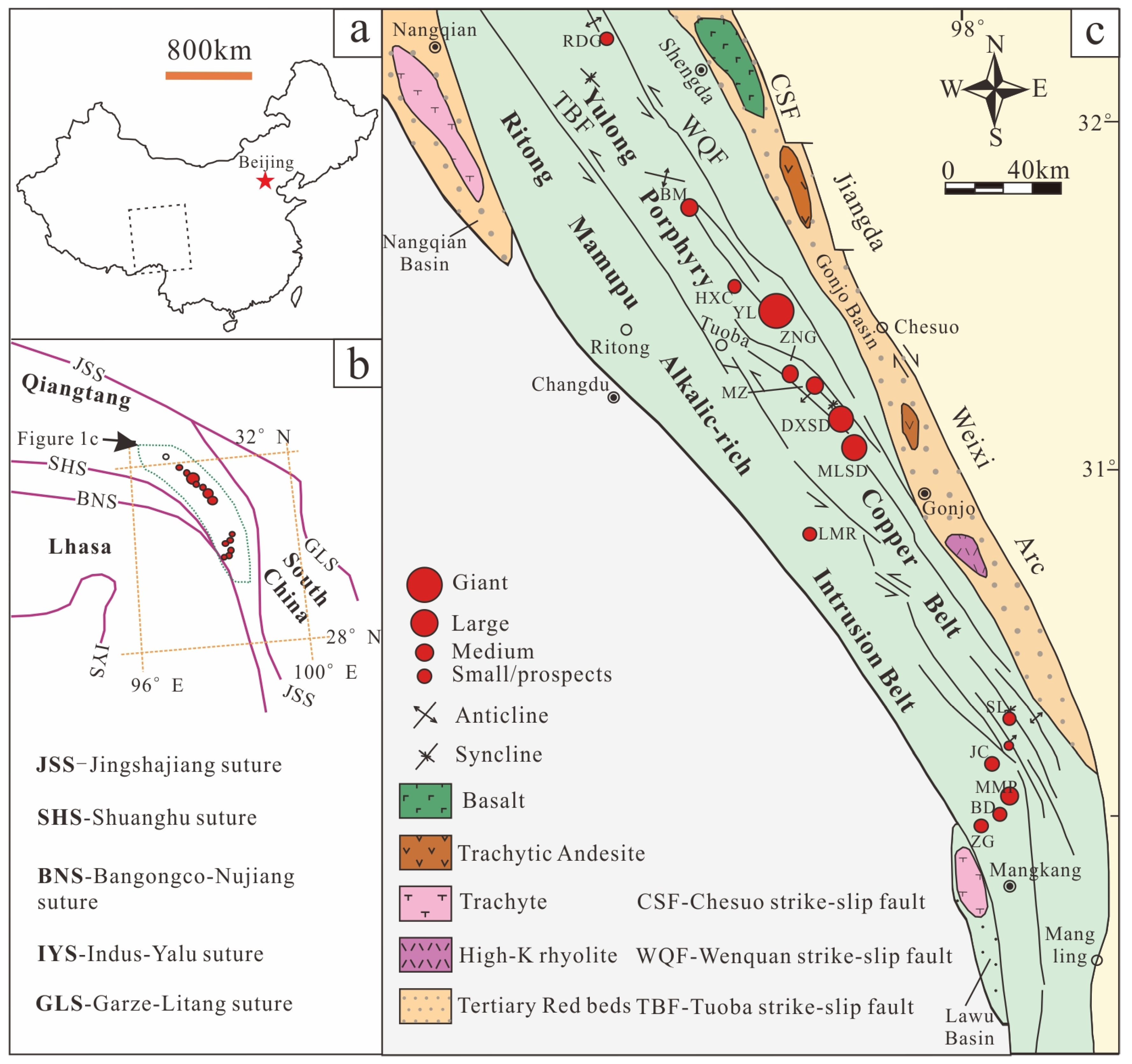

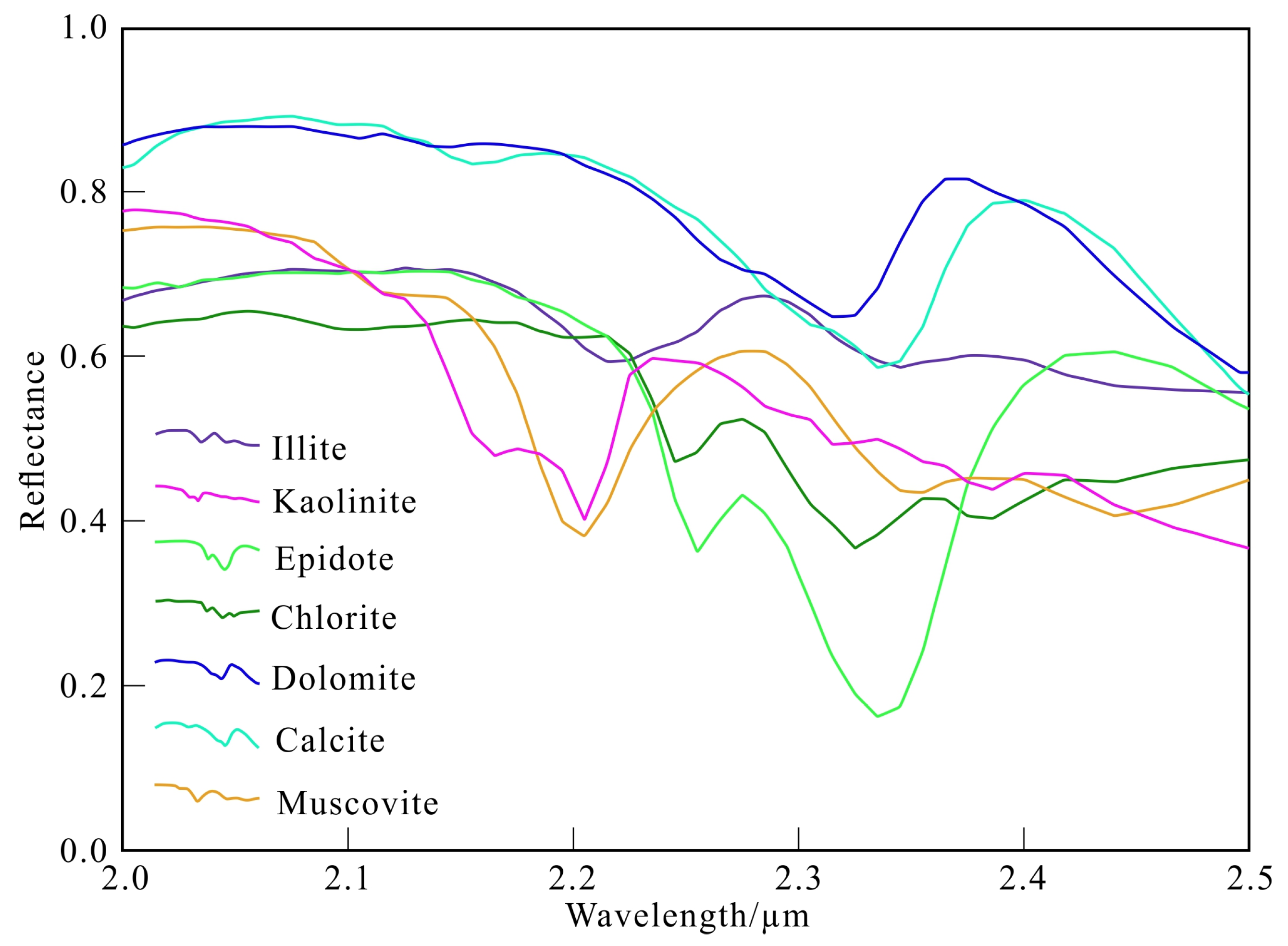
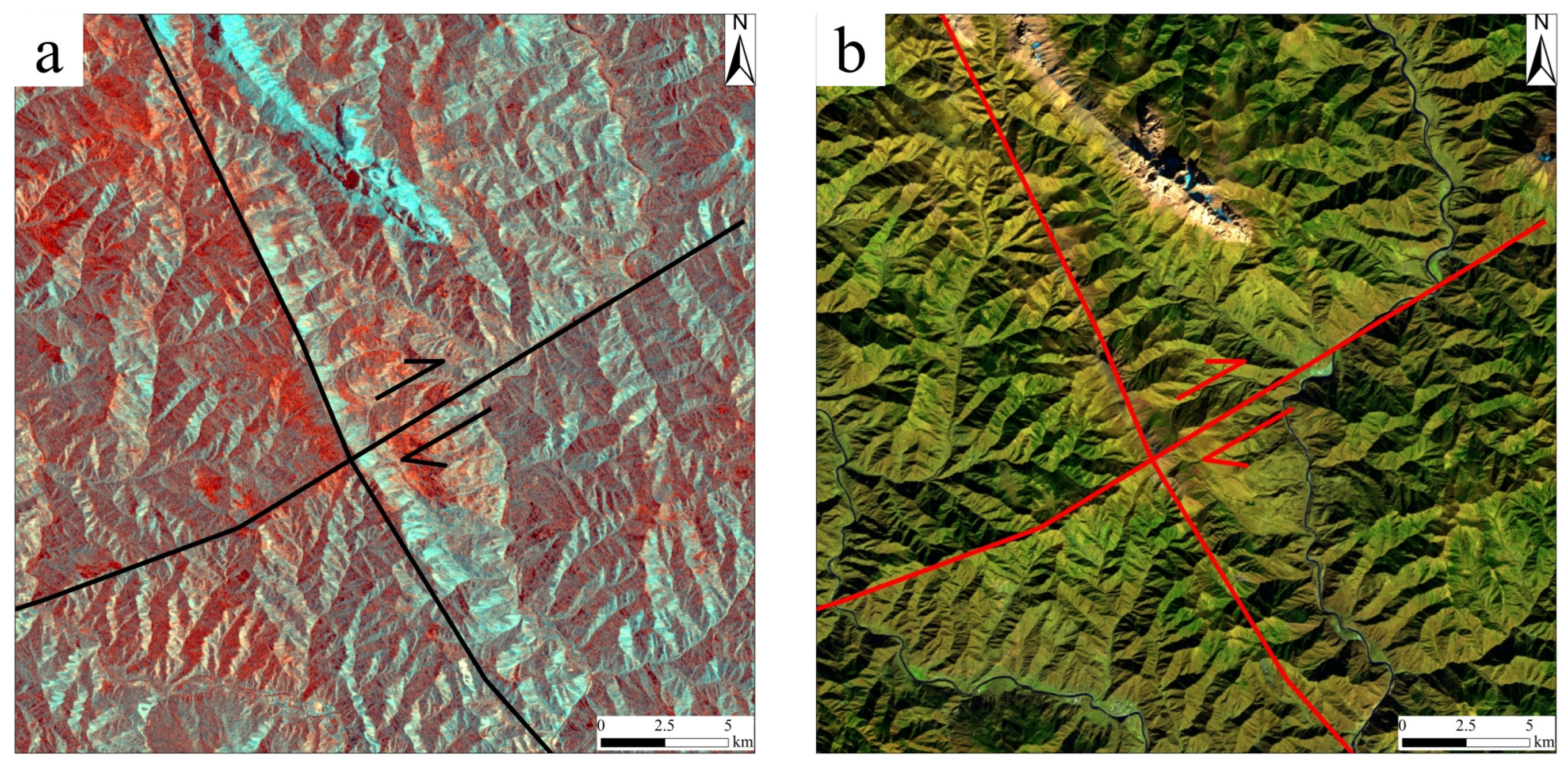
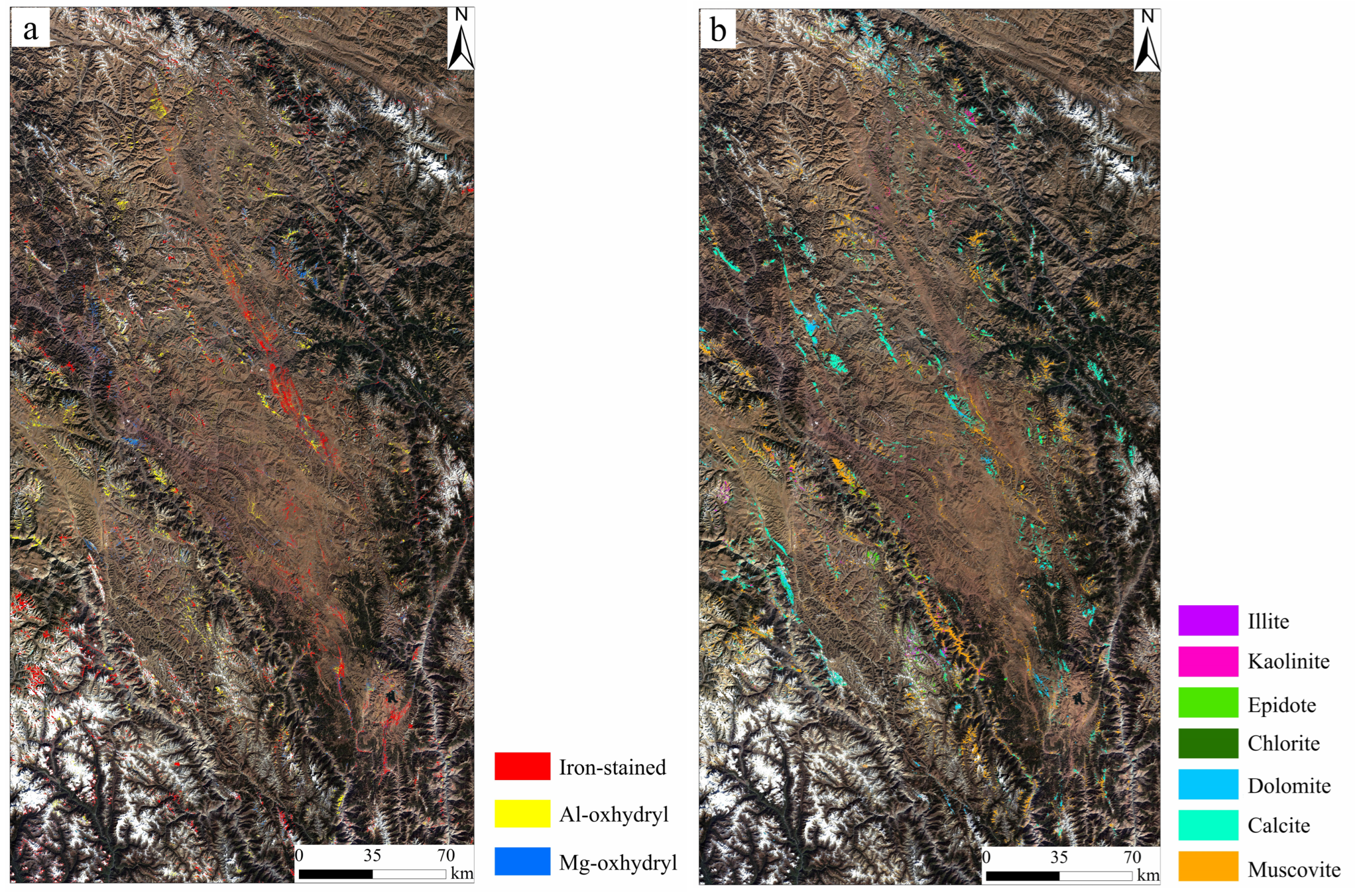
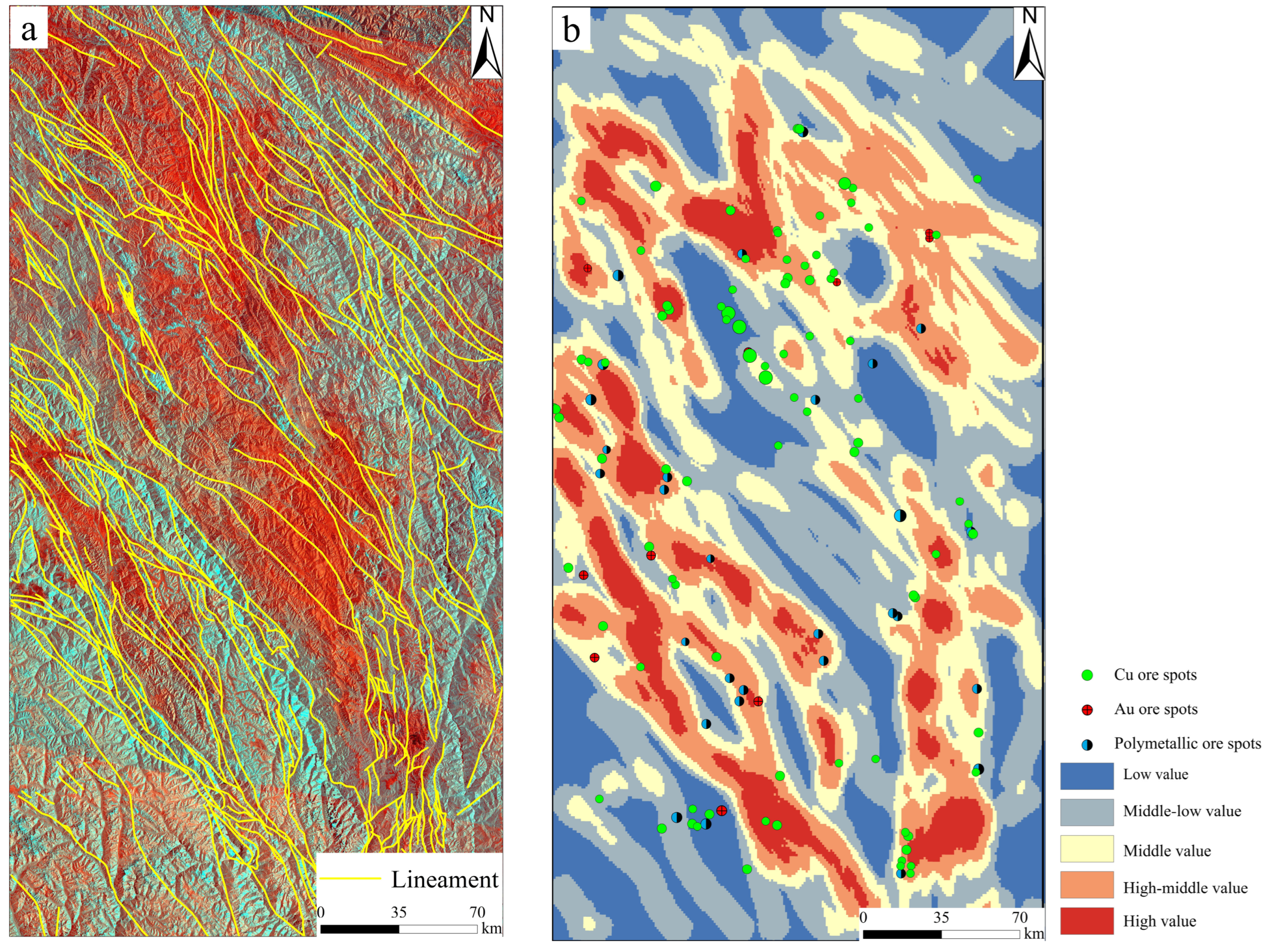
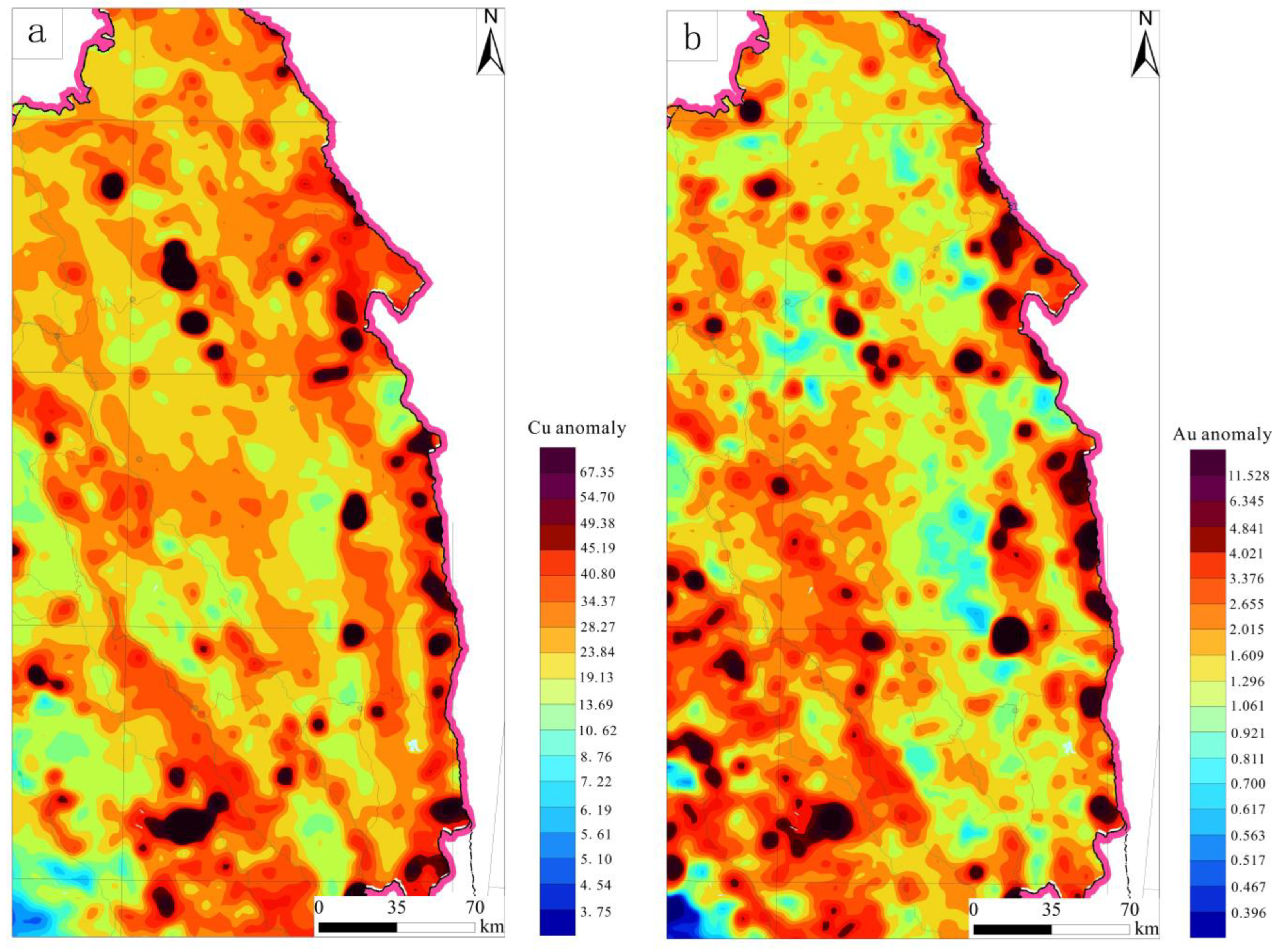
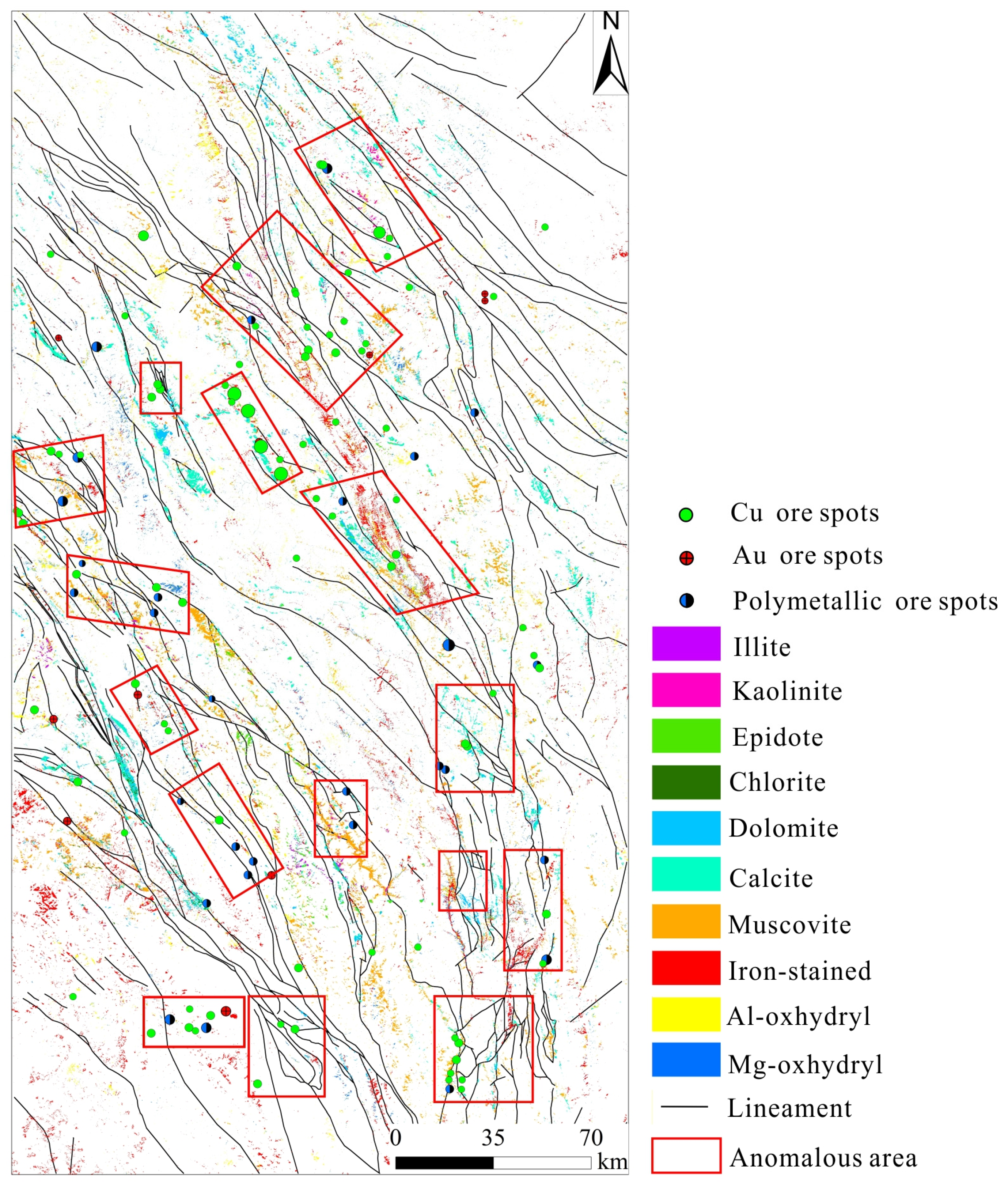
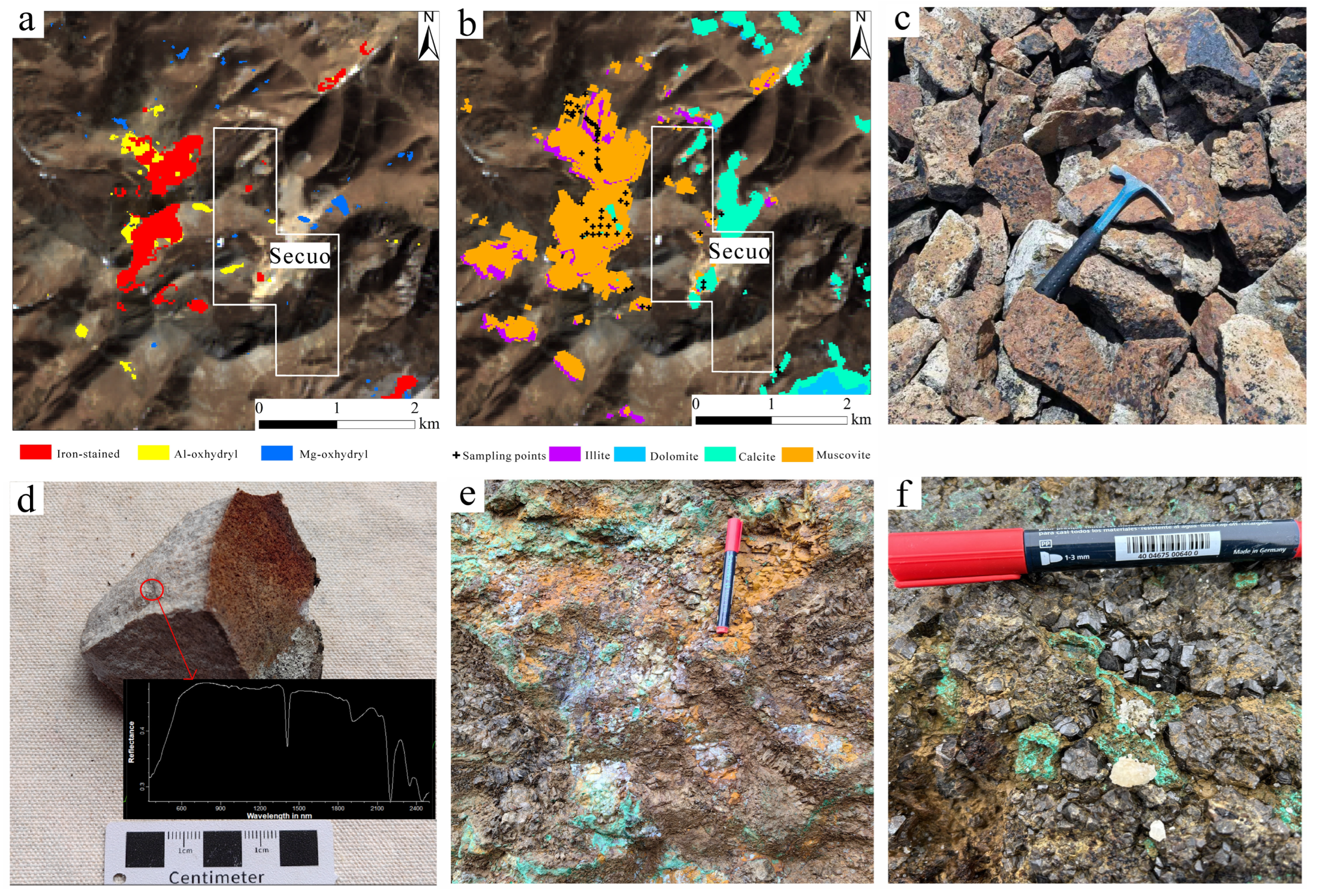
| Landsat-8 OLI | ASTER | ||||
|---|---|---|---|---|---|
| Wave Band | Wavelength/μm | Spatial Resolution/m | Wave Band | Wavelength/μm | Spatial Resolution/m |
| Band1 Coastal | 0.43–0.45 | 30 | |||
| Band2 Blue | 0.45–0.51 | 30 | |||
| Band3 Green | 0.53–0.59 | 30 | Band1 Green | 0.52–0.60 | 15 |
| Band4 Red | 0.64–0.67 | 30 | Band2 Red | 0.63–0.69 | 15 |
| Band5 NIR | 0.85–0.88 | 30 | Band3N NIR | 0.78–0.86 | 15 |
| Band3B | 0.78–0.86 | 15 | |||
| Band6 SWIR1 | 1.58–1.65 | 30 | Band4 SWIR1 | 1.60–1.70 | 30 |
| Band7 SWIR2 | 2.11–2.29 | 30 | Band5 SWIR2 | 2.145–2.185 | 30 |
| Band6 SWIR3 | 2.185–2.225 | 30 | |||
| Band8 Pan | 0.50–0.68 | 15 | Band7 SWIR4 | 2.235–2.285 | 30 |
| Band9 Cirrus | 1.36–1.38 | 30 | Band8 SWIR5 | 2.295–2.365 | 30 |
| Band9 SWIR6 | 2.360–2.430 | 30 | |||
| Satellite Sensor | GF-5 AHSI | ZY1-02D AHSI |
|---|---|---|
| Spectral range/μm | 0.45–2.5 | |
| Number of spectral channels | 330 | 166 |
| Spectral resolution (VNIR)/nm | 5 | 10 |
| Spectral resolution (SWIR)/nm | 10 | 20 |
| Spatial resolution/m | 30 | 30 |
| Width/km | 60 | 60 |
| Eigenvectors | OLI2 | OLI4 | OLI5 | OLI6 |
|---|---|---|---|---|
| PC1 | 0.144101 | 0.335882 | 0.496055 | 0.787622 |
| PC2 | 0.398654 | 0.589867 | 0.400577 | −0.576775 |
| PC3 | 0.488158 | 0.390769 | −0.749814 | 0.216288 |
| PC4 | 0.762897 | −0.621723 | 0.176765 | 0.014228 |
| Eigenvectors | ASTER1 | ASTER3 | ASTER4 | ASTER6 |
| PC1 | 0.209560 | 0.397973 | 0.232984 | 0.511177 |
| PC2 | 0.766223 | 0.499220 | −0.354752 | −0.194506 |
| PC3 | 0.561645 | −0.733563 | −0.028445 | 0.381615 |
| PC4 | −0.231392 | 0.232984 | −0.580467 | 0.745141 |
| Eigenvectors | ASTER1 | ASTER3 | ASTER4 | ASTER8 |
| PC1 | 0.229429 | 0.419489 | 0.750621 | 0.456025 |
| PC2 | 0.766392 | 0.466710 | −0.426878 | −0.112250 |
| PC3 | 0.479851 | −0.715509 | −0.053543 | 0.504900 |
| PC4 | −0.360207 | 0.307014 | −0.501474 | 0.724236 |
Disclaimer/Publisher’s Note: The statements, opinions and data contained in all publications are solely those of the individual author(s) and contributor(s) and not of MDPI and/or the editor(s). MDPI and/or the editor(s) disclaim responsibility for any injury to people or property resulting from any ideas, methods, instructions or products referred to in the content. |
© 2024 by the authors. Licensee MDPI, Basel, Switzerland. This article is an open access article distributed under the terms and conditions of the Creative Commons Attribution (CC BY) license (https://creativecommons.org/licenses/by/4.0/).
Share and Cite
Feng, Y.; Dai, J.; Bai, L.; Wu, C. Prospecting Prediction for the Yulong Metallogenic Belt in Tibet Based on Remote Sensing Alteration Information and Structural Interpretation. Remote Sens. 2024, 16, 1343. https://doi.org/10.3390/rs16081343
Feng Y, Dai J, Bai L, Wu C. Prospecting Prediction for the Yulong Metallogenic Belt in Tibet Based on Remote Sensing Alteration Information and Structural Interpretation. Remote Sensing. 2024; 16(8):1343. https://doi.org/10.3390/rs16081343
Chicago/Turabian StyleFeng, Yilin, Jingjing Dai, Longyang Bai, and Changyu Wu. 2024. "Prospecting Prediction for the Yulong Metallogenic Belt in Tibet Based on Remote Sensing Alteration Information and Structural Interpretation" Remote Sensing 16, no. 8: 1343. https://doi.org/10.3390/rs16081343






